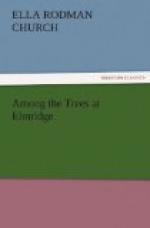“A fig tree having leaves,” said Miss Harson, “should also have figs, for these, as I have already told you, appear before the leaves, and both are on the tree at the same time; so that, although unripe figs are seen without leaves, leaves should not be seen without figs; and if it was not yet the season for figs, it was not the season for leaves either. The barren fig tree has often been compared to people who make a show of goodness in words, but leave the doing of good works to others; and when anything is expected of them, there is sure to be disappointment. ‘Nothing but leaves’ has become a proverb; and when it can be used to express the barren condition of those who profess to follow the teachings of our Lord, it is sad indeed.”
“Do fig trees grow wild?” asked Clara, presently.
“Yes,” was the reply, “and very curious-looking things they are. ’Their roots twist into all kinds of whimsical contortions, so as to look more like a mass of snakes than the roots of a tree. They unite themselves so closely to the substances that come in their way, such as the face of rocks, or even the stems of other trees, that nothing can pull them away. And in some parts of India these strong, tough roots are made to serve the purpose of bridges and twisted over some stream or cataract. The wild fig is often a dangerous parasite, and does not attain perfection without completing some work of destruction among its neighbors in the forest. A slender rootlet may sometimes be seen hanging from the crown of a palm. The seed was carried there by some bird that had fed upon the fruit of a wild fig, and it rooted itself with surprising facility. The rootlet, as it descends, envelops the column-like stem of the palm with a woody network, and at length reaches the ground. Meanwhile, the true stem of the parasite shoots upward from the crown of the palm. It sends out numberless rootlets, each of which, as soon as it reaches the ground, takes root; and between them the palm is stifled and perishes, leaving the fig in undisturbed possession. The parasite does not, however, long survive the decline; for, no longer fed by the juices of the palm, it also, in process of time, begins to languish and decline.’”
“What a mean thing it is!” exclaimed Malcolm—“as mean as the cuckoo, that lays its eggs in other birds’ nests. And I’m glad it dies when it has killed the palm tree; it just serves it right. But don’t figs ever grow in this country, Miss Harson?”
“Yes,” replied his governess; “they are cultivated in the Southern States and in California, like many other semi-tropical fruits, and are principally eaten fresh, but for drying they are not equal to the imported ones. No doubt the cultivation of figs in California will become a prosperous trade, for the climate and circumstances there are much like those of Syria.”
[Illustration: DWARF FIG TREE IN A POT.]




